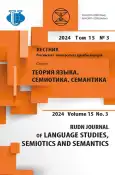Семиотика визуальной метафоры в мексиканском электоральном дискурсе: на примере президентской избирательной кампании 2024 г.
- Авторы: Ларионова М.В.1, Мосина С.К.1
-
Учреждения:
- Московский государственный институт международных отношений (университет) Министерства иностранных дел Российской Федерации
- Выпуск: Том 15, № 3 (2024)
- Страницы: 1021-1039
- Раздел: ФУНКЦИОНАЛЬНАЯ СЕМАНТИКА, ГРАММАТИКА И СТИЛИСТИКА
- URL: https://journal-vniispk.ru/2313-2299/article/view/323599
- DOI: https://doi.org/10.22363/2313-2299-2024-15-3-1021-1039
- EDN: https://elibrary.ru/KFYAXU
- ID: 323599
Цитировать
Полный текст
Аннотация
Актуальность исследования объясняется необходимостью рассмотреть особенности функционирования механизмов дискурсивного смыслообразования и эффективного воздействия на получателей информации с учетом новых лингвосемиотических возможностей современной политической коммуникации, которая реализуется как в реальной, так и в виртуальной цифровой среде, где возрастающую роль обретают мультимедийные технологии, позволяющие кодировать дискурсивные сообщения, используя семиотически поликодовый формат, комбинирующий вербальный способ представления информации с иконическим, цветовым, графическим, метатекстовым и иными форматами. Цель исследования - доказать, что семиотические параметры визуальной метафоры как поликодового знака, функционирующего в дискурсивной среде в рамках прагматической ситуации «Выборы», детерминируют его интерпретативно-смысловой потенциал и при взаимодействии с другими знаковыми кодами приводят к возникновению новых смыслов и интерпретаций. Материалом для изучения визуальных метафор выбраны официальные логотипы, используемые в ходе избирательной кампании 2024 г. в Мексике. Методика исследования, позволяющая обеспечить системное изучение семиотики визуальных метафор, опирается на междисциплинарную и полипарадигмальную модель дискурсологии и имплицирует интегральный подход, сочетающий общенаучные методы анализа и синтеза, сравнения и аналогии с методом социолингвистической интерпретации, семантическим, интерпретативным, лингвокогнитивным и дискурс-анализом. Установлено, что лингвосемиотическая парадигма мексиканского электорального дискурса интегрирует языковые и невербальные семиотические коды для выражения смыслов, концептуализации и категоризации действительности. С помощью различных знаковых кодов метафора-логотип конденсирует смысловое содержание и в качестве когнитивной модели, основанной на аналогии, выступает средством смыслообразования, моделирующим восприятие мира в интересах адресанта. Использование многозначных иконических знаков-образов, понятных широкой аудитории избирателей, транслирует коннотативные, идеологические и социальные смыслы. Таким образом, визуальная метафора как способ логического осмысления и вербализации реальности функционирует в качестве значимого компонента когнитивного пространства электорального дискурса. © Ларионова М.В., Мосина С.К., 2024
Ключевые слова
Об авторах
Марина Владимировна Ларионова
Московский государственный институт международных отношений (университет) Министерства иностранных дел Российской Федерации
Автор, ответственный за переписку.
Email: larionova.m@list.ru
ORCID iD: 0000-0001-6466-7363
SPIN-код: 5303-1160
Scopus Author ID: 57207834882
ResearcherId: E-3214-2016
доктор филологических наук, доцент, профессор кафедры испанского языка
119454, г. Москва, проспект Вернадского, д. 76София Константиновна Мосина
Московский государственный институт международных отношений (университет) Министерства иностранных дел Российской Федерации
Email: sophiemosina@yandex.ru
ORCID iD: 0000-0002-0569-9717
SPIN-код: 4201-8787
аспирант, преподаватель кафедры испанского языка
119454, г. Москва, проспект Вернадского, д. 76Список литературы
- Larionova, M.V. & Demkina, A.V. (2021). Hashtag as a Linguocognitive Unit of Spanish Political Discourse. RUDN Journal of Language Studies, Semiotics and Semantics, 12(3), 774–788. https://doi.org/10.22363/2313-2299-2021-12-3-774-788 (In Russ.).
- Budaev, E.V. (2016). Critical analysis of political discourse: main trends of contemporary foreign research. Political linguistics, 6(60), 12–17. (In Russ.).
- Vershinin, M.S. (2001). Political communication in information society. Saint Petersburg: Mikhailov V.A. Publ. (In Russ.).
- Klyuev, Yu.V. (2010). Political discourse in mass communication: analysis of public political interaction. St.Petersburg: SPBU Publ. (In Russ.).
- Mikhaleva, O.L. (2009). Political discourse: Specificity of manipulative influence. Moscow: Library House. (In Russ.).
- Chernyavskaya, V.E. (2014). The discourse of power and the power of discourse: problems of speech influence. Moscow: Flint-Media. (In Russ.).
- Chudinov, A.P. (2006). Political linguistics. Moscow: Flinta, Nauka. (In Russ.).
- Sheigal, E.I. (2004). Semiotics of political discourse. Moscow: Gnosis. (In Russ.).
- Dijk, T.A. van. (2006). Discourse and manipulation. London: SAGE Publ.
- Farrelly, M. (2015). Discourse and Democracy. Critical Analysis of the Language of Government. London: Routledge.
- Hart, C. (2014). Discourse, Grammar and Ideology. Functional and Cognitive Perspectives. London: Bloomsbury Academic.
- Chilton, P.A. (2004). Analysing political discourse: theory and practice. London: Routledge; Taylor & Francis.
- Fairclough, I. & Fairclough, N. (2012). Political Discourse Analysis. A Method for Advanced Students. London: Routledge.
- Pavlina S.Yu. (2021). Translation Perspective on Persuasive Strategy Implementation in American Pre-Electoral Discourse. MCU Journal of Philology. Theory of Linguistics. Linguistic Education, 2(42), 66–74. https://doi.org/10.25688/2076-913X.2021.42.2.07 (In Russ.).
- Larionova, M.V. (2024). Linguosemiotics of Electoral Discourse (A Study of the Election Campaigns in Spain, 2023). Political Linguistics, 3(105), 21–32. (In Russ.).
- Chaney, P. (2013). Electoral discourse and formative structural narratives of welfare divergence in multi-level systems: homelessness policy in UK elections 1970–2011. Journal of International and Comparative Social Policy, 29(1), 28–47.
- Benoit, W.L. (2003). Topic of presidential campaign discourse and election outcome. Western Journal of Communication, 67(1), 97–112.
- Zasursky, I.I. (1999). Mass media of the second republic. Moscow: MSU Publ. (In Russ.).
- Popova, O.V. (2017). Metaphor as a cognitive tool for creating visual imagery. Issues in Journalism, Education, Linguistics, 7(256), 194—198. (In Russ.).
- Chernyavskaya, V.E. (2017). Speech influence in political, advertising and Internet discourse. Moscow: Lenand. (In Russ.).
- Chulkina, N.L. & Makashova, V.V. (2024). Visual Metaphors in Pedagogical Discourse. RUDN Journal of Language Studies, Semiotics and Semantics, 15(1), 211–231. https://doi.org/10.22363/2313-2299-2024-15-1-211-231 (In Russ.).
- Isakova, E.M. & Kryukova, N.F. (2021). Visual metaphor and ways of its identification. Vestnik TvGU Series: Philology, 4(71), 95–100. https://doi.org/10.26456/vtfilol/2021.4.095 (In Russ.).
- Bolshakova, L.S. (2008). Cognitive mechanism of creating visual metaphors in English musical video clips. Modern Problems of Science and Education, 2. (In Russ.).
- Arutyunova, N.D. (1990). Metaphor and discourse. Theory of metaphor. Moscow. (In Russ.).
- Slovikova, E.L. & Eltsova, M.N. (2012). Synergetic categories of discourse (advertising discourse data). Perm University Herald. Russian and Foreign Philology, 2(18), 67–83. (In Russ.).
- Roa-Castellanos, R.A. (2018). La política de colores: ¿Partidos naranja? Universidad del Rosario. URL: https://urosario.edu.co/revista-nova-et-vetera/columnistas/la-politica-decolores-partidos-naranja (accessed: 09.07.2024).
- Austin, J.L. (1962). How to do things with words. Oxford.
- Hall, S. (1980). Encoding, decoding in the television discourse. Culture, Media, Language. London: Hutchinson.
Дополнительные файлы









